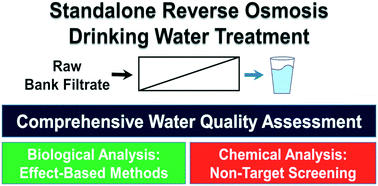Evaluation of reverse osmosis drinking water treatment of riverbank filtrate using bioanalytical tools and non-target screening†
Abstract
Stand-alone reverse osmosis (RO) has been proposed to produce high-quality drinking water from raw riverbank filtrate impacted by anthropogenic activities. To evaluate RO efficacy in removing organic micropollutants, biological analyses were combined with non-target screening using high-resolution mass spectrometry and open cheminformatics tools. The bank filtrate induced xenobiotic metabolism mediated by the aryl hydrocarbon receptor AhR, adaptive stress response mediated by the transcription factor Nrf2 and genotoxicity in the Ames-fluctuation test. These effects were absent in the RO permeate (product water), indicating the removal of bioactive micropollutants by RO membranes. In the water samples, 49 potentially toxic compounds were tentatively identified with the in silico fragmentation tool MetFrag using the US Environmental Protection Agency CompTox Chemicals Dashboard database. 5 compounds were confirmed with reference standards and 16 were tentatively identified with high confidence based on similarities to accurate mass spectra in open libraries. The bioactivity data of the confirmed chemicals indicated that 2,6-dichlorobenzamide and bentazone in water samples can contribute to the activation of AhR and oxidative stress response, respectively. The bioactivity data of 7 compounds tentatively identified with high confidence indicated that these structures can contribute to the induction of such effects. This study showed that riverbank filtration followed by RO could produce drinking water free of the investigated toxic effects.

- This article is part of the themed collection: Research from our newest ESPI Editorial Board members


 Please wait while we load your content...
Please wait while we load your content...